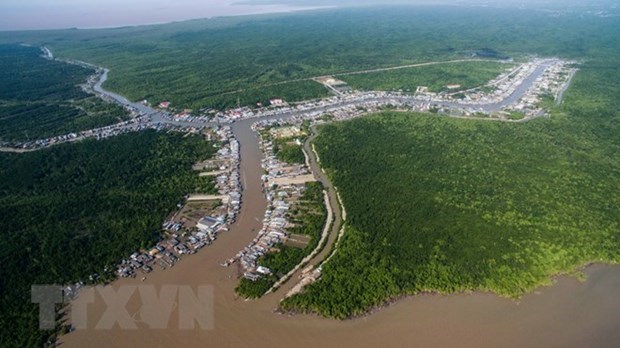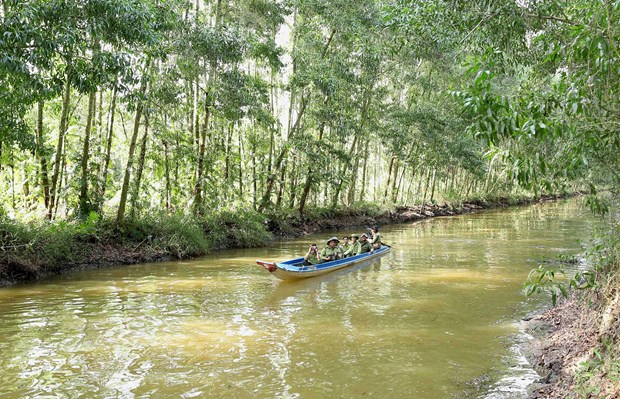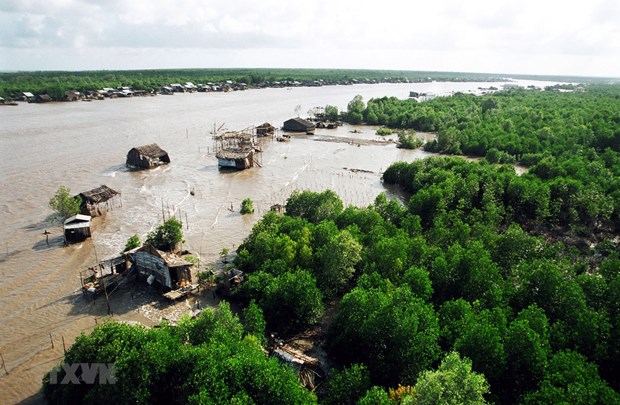Ca Mau: People join hands in developing eco-tourism
Visitors to the Cape of Ca Mau nowadays are attracted to not only its cultural and historical values but also community-based eco-tourism that is growing more and more strongly.
 An aerial view of the Mui Ca Mau (Ca Mau Cape) National Park (Photo: VNA)
An aerial view of the Mui Ca Mau (Ca Mau Cape) National Park (Photo: VNA)Ca Mau (VNA) – Visitors to the Cape of Ca Mau nowadays are attracted to not only its cultural and historical values but also community-based eco-tourism that is growing more and more strongly.
Flourishing eco-tourism
With abundant natural resources, the southernmost province of Ca Mau considers developing green tourism, conserving biodiversity and encouraging residents’ responsible engagement as the key to sustainably develop the tourism industry.
There are 14 community-based eco-tourism sites across Ca Mau at present. Most of them are located in Ngoc Hien, Tran Van Thoi and Thoi Binh districts and Ca Mau city, according to the division for tourism management at the provincial Department of Culture, Sports and Tourism.
The strong development of community-based eco-tourism has helped create jobs for local people and improve their income while facilitating their participation in forest protection.
One of the outstanding eco-tourism sites is owned by Nguyen Van Nhuan, also called Tu Nhuan, in Con Mui hamlet of Dat Mui commune, Ngoc Hien district. It took shape in 2014 thanks to the initial support of the Swedish International Development Cooperation Agency (SIDA).
The site covers 9.1 hectares of submerged forest which is also combined with aquatic farming. Here, tourists can relax in stilt houses above water, visit the mangrove forest and enjoy the typical fresh seafood of the submerged forest ecosystem.
 Honey of the U Minh Ha cajuput forest is a famous and precious delicacy that Mother Nature has awarded Ca Mau province (Photo: VNA)
Honey of the U Minh Ha cajuput forest is a famous and precious delicacy that Mother Nature has awarded Ca Mau province (Photo: VNA)Additionally, travellers can also sail into shrimp farms, experience fishing or try catching “ba khia” (red crab), “vop” (clam), “oc len” (mud creeper) and “so huyet” (blood cockle). Particularly, through cross-forest tours, they will have a chance to visit alluvial grounds, primeval forests or watch the animals residing under forest canopies.
Nhuan said taking part in community-based tourism, he is always aware of the necessity to protect forests and the environment. In the 9.1-hectare tourism site, he has ensured that 60 percent of the area is for forest and the remaining 40 percent is for aquaculture as in line with regulations.
He and his family’s members understand that protecting forests is also to ensure a stable livelihood. Therefore, all tourism activities must not have negative impact on the environment, he said, noting that his family also often ask visitors not to drop litter but protect the environment.
 A planted forest in Ca Mau (Photo: VNA)
A planted forest in Ca Mau (Photo: VNA)Engaging locals in tourism
Vice Chairman of the provincial People’s Committee Tran Hong Quan said eco-tourism and community-based tourism are the main types of tourism to create breakthroughs in the industry in Ca Mau.
On the basis of the Prime Minister-approved general plan on the Ca Mau Cape national tourism area until 2030 and the programme for developing local tourism in the 2005 – 2010 period, with a vision to 2020, the province has been working to conserve and develop eco-tourism areas in the Cape of Ca Mau and the U Minh Ha National Park, while also boosting travel in Hon Khoai Island, Hon Da Bac Island and the alluvial ground of Khai Long, he noted.
It is promoting experience tourism at community-based sites, along with stepping up communications to raise public awareness of conserving biodiversity, protecting natural resources and upholding local cultural identity, the official added.
 A submerged forest in Ca Mau (Photo: VNA)
A submerged forest in Ca Mau (Photo: VNA)With regard to cross-forest tours in the Mui Ca Mau (Ca Mau Cape) National Park, the Dat Mui tourism area’s management board said tours of submerged forests and alluvial grounds are being organised to offer holidaymakers more experiences and help improve both visitors and locals’ awareness of natural resource protection.
Talking about facilitating green tourism and encouraging the community’s participation, Director of the provincial Department of Culture, Sports and Tourism Tran Hieu Hung affirmed for Ca Mau, tourism resources are priceless assets that must be conserved and brought into play sustainably. He noted the province’s tourism development strategy takes into account the local culture and community so that people understand protecting forests is for their own sake, and if forests are lost, consequences will be unpredictable.
While developing tourism products, especially eco- and community-based ones, authorities and travel businesses always pay attention to creating livelihoods for local residents. When opening cross-forest tours, they have assisted the households which are unable to fish offshore amid inshore fishing restriction to supply suitable tourism services, Hung said./.













